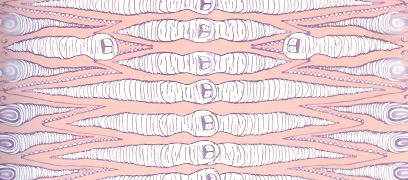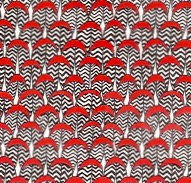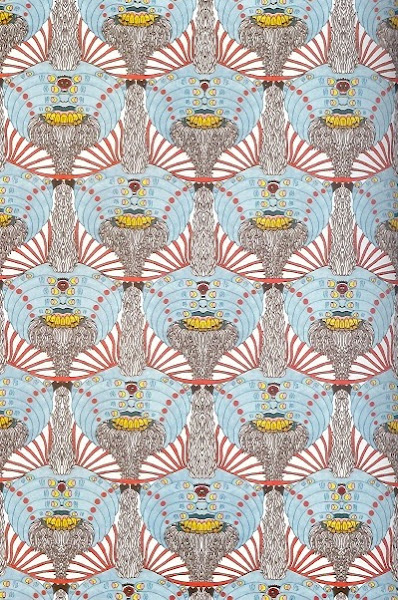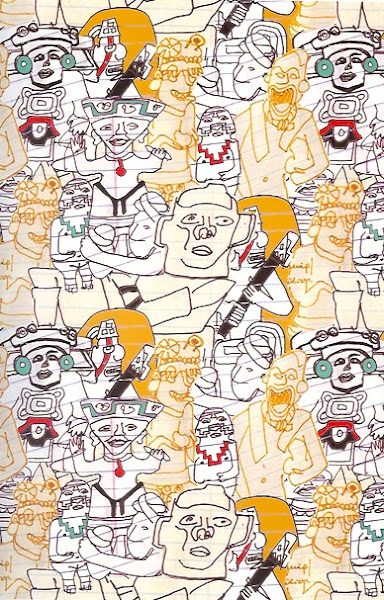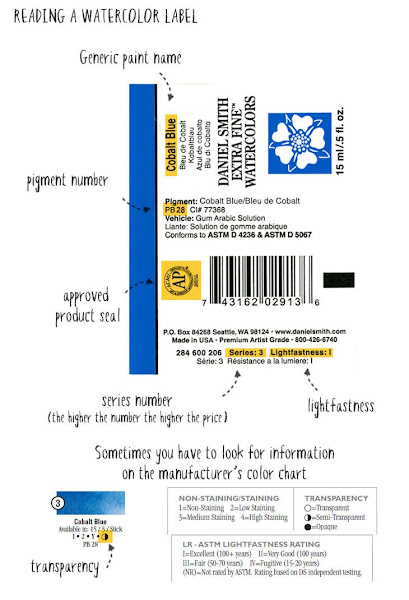Preamble
For you convenience I have listed below other posts in this series which were sourced from the book - The Pattern Base[1]:
The Pattern Base by Kristi O'Meara - Book Review
The Art of Lorenzo Nanni
The Geometric Abstract Designs of Kristi O'Meara
Representational Designs of Kristi O'Meara
Geometric Patterns Designed by Patrick Morissey and Jasmin Elisa Guerrero
Fabric Swatches - Part I
Hannah Truran
Fabric Swatches - Part II
Fabric Swatches - Part III
Fabric Swatches - Part IV
Introduction
Kristi O'Meara is a surface designer & illustrator based Chicago, IL. She is the founder of design studio and blog, The Patternbase. She received her bachelor of fine arts in 2009 from the Kansas City Art Institute, where she studied painting, design, and fiber arts. Kristi released her first publication, The Pattern Base: Over 550 Contemporary Textile and Surface Designs through Thames & Hudson Publishing in 2015. Her work has been featured in Chicago Magazine, IdN, Cool Hunting, CS | Modern Luxury, and Dutch Elle, among others.
For more information about her career, activities and interests please click on the following link - Kristy O'Meara
Representational Designs of Kristi O'Meara[1]
Dandelion Ducks (2013).
Ants Attack (2013).
White Worms (2012).
Chevron Beetle Wings (2012).
Worms (2012).
Playful Polyphemus (2012).
Mesoamerican Idols (2012).
Happy Gnomes (2011).
Kachina Dance (2011).
Homestead (2011).
Tentacle Mosaic (2012).
Reference:
[1] K. O'Meara, The Pattern Base, Thames & Hudson London (2015).
Preamble
On this blog spot there are posts that center on my “Wearable Art” (e.g. scarves, digital or analogue created fabric lengths etc.) For your convenience I have listed these posts below.
A Selection of My Scarves
Leaves Transformed: A New Collection of My Digitally Designed Fabrics
My New Silk Rayon Velvet Scarves@Purple Noon Art And Sculpture Gallery
My Fabric Lengths@QSDS
My Fabric Collection:"Oh, Oh Marilyn and Mona!"@Spoonflower
2013 Australian Craft Awards – Finalist
My Scarves@2014 Scarf Festival: "Urban Artscape" Pashminas
My New Scarves and Fabric Lengths
New Range of Silk Neckties - Karma and Akash
AIVA: My New Hand Dyed and Hand Printed Fabric Design
New Colorways For My 'Cultural Graffiti' Fabrics
Byzantine Glow: A New Collection of My Digitally Designed Fabrics
Wall Flower: A New Collection of My Digitally Designed Fabrics
Ink Fern - A New Collection of My Digitally Designed Fabrics
Celebratory Fireworks
My New Silk ArtCloth Scarves
New ‘Unique State’ Silk ArtCloth Scarves
UBIRR - My New Hand Dyed & Printed Fabric Design
Renaissance Man - My New Hand Dyed & Printed Fabric Design
Banksia - My New Hand Dyed and Hand Printed Fabric Design
Ginkgo Love - My New Hand Dyed and Hand Printed Fabric Design
Garden Delights I & II - My New Hand Dyed and Hand Printed Fabric Design
Wallflower III - My New Hand Dyed and Hand Printed Fabric Design
Rainforest Beauty - Collection My New Hand Dyed and Hand Printed Fabric Design
Spring & Autumn Flurry Collection - My New Hand Dyed and Hand Printed Fabric Design
La Volute Collection - My New Hand Dyed and Hand Printed Fabric Design
Urban Butterfly - My New Hand Printed Fabric Design
Acanthus Dream - My New Hand Printed Fabric Design
“Cascading Acanthus” - My New Hand Dyed and Hand Printed Fabric Design
My New Hand Dyed and Hand Printed 'Rainforest Beauty' Pashmina Wraps Collection
My ArtCloth Tea Towels: A New Collection of Digitally Designed Products
Through the Land it Roared . . . ArtCloth Shawl
My New Hand Dyed and Hand Printed ‘Urban Codes - Series 1’ Collection
Urban Moonlight - My Post Graffiti Doily
My New Hand Printed Fabric Design - "Morocco" ArtCloth
‘Vine Glow’
“Bush Banksia’s” Collection"
Releasing My New - ‘Unique State’ ArtCloth Scarves
‘LRSP’ A New Collection of Digitally Designed ArtCloth Textiles
If you like any of my artworks in the above links, please email me at - Marie-Therese - for pricing and for any other enquiries.
Introduction
I have been designing my hand dyed and hand printed fabric lengths using a range of fabrics and multiple surface design techniques. As a professional senior graphic designer/illustrator in a previous career, I have always had an interest in creating imagery, prints, illustrations, posters and publications using digital processes. This interest has led me to some fascinating explorations in the field of digitally created fabrics and textiles. This post focusses on my new range of original, digitally designed tea towels. The eco-friendly textile printed tea towels have been chosen from a number of my personal design collections which feature at the following link: My Spoonflower Fabrics.
Numerous surface design techniques have been used to create the various textile design collections which have been translated into the digital print format to create superb complimentary colorways. The colors have been sensitively and painstakingly created to encompass the specific concepts associated with each contemporary collection. Each unique design employs a mirror repeat pattern technique. My ArtCloth tea towel designs are printed edge to edge over the entire item.
A New Collection of My Digitally Designed ArtCloth Tea Towels
These uniquely crafted tea towels are perfect for lint free drying of dishes and add an individual and colorful statement to your kitchen decor. To complement the tea towel design, other products, such as table cloths, placemats, table runners, dinner napkins, and pillows can also be crafted to create a highly personalized and co-ordinated kitchen and dining home décor experience.
The tea towels measure 16 inches in width x 24 inches in height and are printed onto natural white, eco-friendly linen-cotton-canvas fabric. The hems are folded and topstitched, and a white hang tab is included on the back of the tea towel. The tea towels soften and become more absorbent with use.
If you would like to purchase any of my ArtCloth tea towels please email me at - Marie-Therese - for pricing and/or any other information. There is no minimum order and they would make a lovely gift for your friends and family to boot!
To view the various colorways that are available in my Artquill Collections at Spoonflower click on the following - My Spoonflower Fabrics.
Title: ‘Fleeting.’ My ArtCloth Tea Towel Collection.
Comment: The tea towel design is one of three complementary colorways.
Title: ‘LRSP.’ My ArtCloth Tea Towel Collection.
Comment: The tea towel design is one of five complementary colorways.
Title: ‘Wall Flower.’ My ArtCloth Tea Towel Collection.
Comment: The tea towel design is one of five complementary colorways.
Title: ‘Waxing Lyrical.’ My ArtCloth Tea Towel Collection.
Comment: The tea towel design is one of four complementary designs.
Title: ‘Celebratory Fireworks.’ My ArtCloth Tea Towel Collection.
Comment: The tea towel design is one of five complementary colorways.
Title: ‘Leaves Transformed.’ My ArtCloth Tea Towel Collection.
Comment: The tea towel design is one of six complementary colorways.
Preamble
This is the sixth post in a new Art Resource series that specifically focuses on techniques used in creating artworks. For your convenience I have listed all the posts in this new series below:
Drawing Art
Painting Art - Part I
Painting Art - Part II
Painting Art - Part III
Painting Art - Part IV
Painting Art - Part V
Painting Art - Part VI
Home-Made Painting Art Materials
Quality in Ready-Made Artists' Supplies - Part I
Quality in Ready-Made Artists' Supplies - Part II
Quality in Ready-Made Artists' Supplies - Part III
Historical Notes on Art - Part I
Historical Notes on Art - Part II
Historical Notes on Art - Part III
Historical Notes on Art - Part IV
Historical Notes on Art - Part V
Tempera Painting
Oil Painting - Part I
Oil Painting - Part II
Oil Painting - Part III
Oil Painting - Part IV
Oil Painting - Part V
Oil Painting - Part VI
Pigments
Classification of Pigments - Part I
Classification of Pigments - Part II
Classification of Pigments - Part III
Pigments for Oil Painting
Pigments for Water Color
Pigments for Tempera Painting
Pigments for Pastel
Japanese Pigments
Pigments for Fresco Painting - Part I
Pigments for Fresco Painting - Part II
Selected Fresco Palette for Permanent Frescoes
Properties of Pigments in Common Use
Blue Pigments - Part I
Blue Pigments - Part II
Blue Pigments - Part III
Green Pigments - Part I
Green Pigments - Part II
Red Pigments - Part I
Red Pigments - Part II
Yellow Pigments - Part I
Yellow Pigments - Part II
Brown and Violet Pigments
Black Pigments
White Pigments - Part I
White Pigments - Part II
White Pigments - Part III
There have been one hundred and thirteen posts in a previous Art Resource series that focused on the following topics:
(i) Units used in dyeing and printing of fabrics.
(ii) Occupational, health & safety issues in an art studio.
(iii) Color theories and color schemes.
(iv) Optical properties of fiber materials.
(v) General properties of fiber polymers and fibers - Part I to Part V.
(vi) Protein fibers.
(vii) Natural and man-made cellulosic fibers.
(viii) Fiber blends and melt spun fibers.
(ix) Fabric construction.
(x) Techniques and woven fibers.
(xi) Basic and figured weaves.
(xii) Pile, woven and knot pile fabrics.
(xiii) Napped fabrics, double cloth and multicomponent fabrics.
(xiv) Fabric finishes.
(xv) Schrinkage, durable press and wash-wear finishes.
(xvi) Classification of dyes and dye blends.
(xvii) The general theory of printing.
To access any of the above resources click on the following link - Units Used in Dyeing and Printing of Fabrics. This link highlights the one hundred and thirteen posts in the previous Art Resource series.
There are eight data bases on this blogspot, namely: (1) the Glossary of Cultural and Architectural Terms; (2) Timelines of Fabrics, Dyes and Other Stuff; (3) A Fashion Data Base; (4) the Glossary of Colors, Dyes, Inks, Pigments and Resins; (5) the Glossary of Fabrics, Fibers, Finishes, Garments and Yarns; (6) Glossary of Art, Artists, Art Motifs and Art Movements; (7) Glossary of Paper, Photography, Printing, Prints and Publication Terms; (8) Glossary of Scientific Terms.
Note: From time-to-time all the above data bases will be updated.
If you find any post on this blog site useful, you can save it or copy and paste it into your own "Word" document for your future reference. For example, Safari allows you to save a post (e.g., click on "File", click on "Print" and release, click on "PDF" and then click on "Save As" and release - and a PDF should appear where you have stored it). Safari also allows you to mail a post to a friend (e.g., click on "File", and then point cursor to "Mail Contents On This Page" and release). Either way, this or any of the other posts on this site may be a useful Art Resource for you.
The new Art Resource series will be the first post in each calendar month. Remember, these Art Resource posts span information that will be useful for a home hobbyist to that required by a final year University Fine-Art student. Undoubtedly, some parts of any Art Resource post may appear far too technical for your needs (skip those mind boggling parts) and whilst other parts may be too simplistic with respect to your level of knowledge (ditto the skip). Hopefully, the trade-off between these two extremes will mean that the Art Resource posts will be useful in parts to most, but unfortunately, may not be satisfying to all!
Painting Art - Part V[1]
(i) Balanced Formulas
In the formulation of a liquid paint in the establishment of a painting technique, there is another fundamental consideration which may be called the "balance of solubility." A certain balance or relation must be maintained between the resistance of the coating, the solvent action of subsequent brush strokes, and the solvent or dispersing power of the liquid used. For instance, the gum binder of water color is completely soluble in water, yet dry paint is sufficiently resistant so that it is possible to apply subsequent brush strokes without it; on the other hand, the paint is so reistant that it cannot be softened or run into when the painter so desires.
The wet paint itself may be instantly diluted or thinned with its normal solvent, water. A poorly-made water color paint, or one which could be called unbalanced in this respect, might be picked up and completely removed at the touch of a wet brush or it might be too dry and too resistant to water to be worked into when desired. The best water color paints are perfectly balanced and adjusted to the normal water color techniques.
In the oil painting technique, the turpentine or mineral spirit has sufficient solvent action to function as a thinner for the wet paint and also to dissolve the freshly applied or recently dried coating if scrubbed into it, yet a freshly dried surface will not pick up, spread or dissolve away if over painted in the correct manner.
Oil paint can be freely mixed and blended if desired. It can be made to set quickly enough to withstand solvent action of further strokes without running in with them, or it can be made to remain plastic long enough for most normal working procedures. If a glaze or overpainting contains acetone, or some other powerful solvent, the underpainting might be pick up or it might spread.
For you techincal enthusiasts, a schematic indication of physicochemical processes that occur simultaneously during cleaning operations, is altogether defined as solvent action. After and during the dissolution of varnish (orange), the paint matrix (yellow) expands in size (shaded yellow) due to the uptake of solvent (blue). The relative thickness of the layers indicated does not represent the actual thickness. The (b) to (e) schematics are examples of possible structure in the polymeric binding medium in oil paint.
(b) Aged ionomeric binding medium with metal carboxylates and high degree of cross-linking;
(c) Cracked ionomeric binding medium with metal carboxylates and high degree of cross-linking (shown crack diameters are not to scale);
(d) Ionomeric binding medium with metal carboxylates and low degree of cross-linking;
(e) Highly oxidized binding medium with intermediate degree of cross-linking and a high concentration of free carboxylic acid groups.
To artists, one of the principal disadvantages of many of the modern lacquers and synthetic resins in painting is they are insoluble in all, but the most powerfully solvent and highly volatile liquids, thus creating obstacles to controlled manipulations.
Some of our traditional techniques are less flexible and their manipulations do not involve the same degree of solubility of recently applied color - for example, fresco and egg tempera, in which the brush strokes if correctly applied are not altered by overpainting and where such effects as gradations of color, tone or shade are normally achieved by hatching or by applying separate strokes.
Other techniques demand various degrees of solubility in their materials, and the standards for paint formulas and ingredients, brushes, grounds, and manipulations used in each vary widely according to its requirements. The fulfillment of all such requirements demands a balance and a proportion in the formulation or design and correct compounding of ingradients.
Mona Lisa is the most famous painting in the world. Implied texture is what we see in this painting – this means the way an object looks as if it would feel, if you could touch it. Da Vinci did not create actual texture by building up paint. It is a visual texture that is evident in the painting.
(ii) Color Stability
One of the prime requirements of a permanent painting technique for artists' use is color stability - the ability of a final dry paint coating to retain its original color effect and the relationship between its colors without any fading, darkening, or change in hue. From the earliest days of painting as a highly developed craft, this matter has been one of the major concerns of painters; it is of fundamental importance in the practice of creative art.
Boston art restoration.
Reference:
[1] The Artist's Handbook of Materials and Techniques, R. Mayer, (ed. E. Smith) 4th Edition, Faber and Faber, London (1981).



